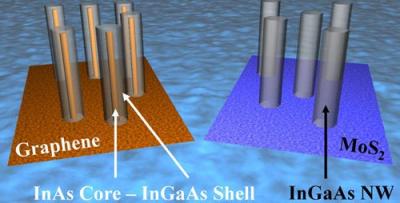Researchers from the University of Illinois discovered that when InGaAs nanowires are grown on graphene, they self-assemble into an unexpected structure, in which the indium arsenide (InAs) acts as a core with an InGaAs shell around it. This structure may be very useful for electronics applications.

The researchers wanted to try graphene as a substrate because silicon (which is most commonly used) is expensive, thick and brittle. Graphene is a lot thinner, and it's flexible, too. Now it turns out that grapheen also offers new, unexpected functionality. And the fact that this structure was built spontaneously is very good, too as it makes it easy to construct such nanowires.
Source:
Posted: Apr 23,2013 by Ron Mertens

